Novel Time-Delay Side-Collision Warning Model at Non-Signalized Intersections Based on Vehicle-to-Infrastructure Communication
Abstract
1. Introduction
2. Side-Collision Warning Model for Intersections
2.1. Model 1: Traditional Side-Collision Warning Model for Non-Signalized Intersections
- (1).
- When the HV reached the conflict point first and the RV reached the conflict point second:
- (2).
- When the RV reached the conflict point first and the HV reached the conflict point second:
2.2. Model 2: Time-Delay Side-Collision Warning Model for Non-Signalized Intersections
- (1).
- Preliminary estimation: The conflict between the HV and RV was preliminarily estimated using indicator T2. T2 refers to the time required for the later arriving vehicle to reach the conflict area when the first arriving vehicle has not yet left the conflict area [28].
- (2).
- Secondary judgment: (a) Considering the vehicle’s position changes during the time period when the driver perceives the warning and system braking gradually takes effect; (b) predicting the trajectory of the vehicle after the brake takes effect; (c) judging whether the vehicle can stop completely within the allowable time or effective distance. Based on the existing emergency braking model established for the driver’s reaction process and braking process [29], this research fully analyzed the position change of the vehicle during the process from warning to complete stop, as shown in Figure 3. The movement process of the vehicle is divided into four stages, namely the reaction stage, the switching stage, the accumulation stage, and the braking stage. The movement of the vehicle in each stage has different characteristics. Point A indicates that the warning is generated, and the vehicle is approaching the intersection; point F means that the vehicle is completely stopped, and the vehicle is at a standstill; point B, point C, point D, and point E are the critical points between each stage. Moreover, the compensation distance of the HV is recorded as and . represents the position change of the HV from warning generation to the reception of information by the driver; indicates the position change of the HV during the process from releasing the accelerator to pressing the brake pedal; denotes the position change of the HV when the braking gradually takes effect. . represents the position change of the vehicle from braking to a complete stop. The following will analyze the changes of vehicle movement from the warning generation to complete parking.
3. Simulation Experiment Design: V2I-Oriented Collision Warning System
3.1. Experiment Platform
3.1.1. Platform Composition and Functions
3.1.2. Human–Machine Interface
3.1.3. System Operation Process
3.2. Experimental Design Instructions
3.2.1. Scenario Design
3.2.2. Definition of Interactive Data Type
3.2.3. Experiment Design and Data Collection
4. Effect Analysis of Warning Model
4.1. Objective Analysis of Warning Effect
4.1.1. Statistical Analysis of Warning Effect
- (1).
- “Available experiments” refers to the records of collision risk and warning indications that actually existed during driving. Among them, for the baseline (no warning model), according to the driving data of HV and RV within the intersection range, the commonly used surrogate safety measure TTC was used to divide the experiment fragments with collision risk and warning requirements.
- (2).
- “Effective warning” represents the experimental fragment in which the driver immediately took avoidance measures and stopped safely after the collision warning was triggered;
- (3).
- “Failure warning” means that the driver took risk avoidance measures before the warning was triggered;
- (4).
- “Invalid warning” means that the system triggered the warning, but the driver did not take corresponding measures to avoid danger;
- (5).
- “Risk resolution” means that the driver identified potential risks and took avoidance measures in advance;
- (6).
- “Collisions” refers to vehicle collisions caused by the driver’s failure to avoid danger.
4.1.2. Analysis of Safety Indicator
- (1).
- Analysis of warning response time
- (2).
- Analysis of conflict time difference
4.1.3. Analysis of Gaze Change
4.2. Subjective Comprehensive Evaluation of Participants
5. Conclusions
- (1).
- The existence of a side-collision warning model at non-signalized intersections played an important role in reducing collision accident rates. Compared with the baseline (no warning model), the traditional model reduced the collision rate to 10.17%; the time-delay model reduced the collision rate to 5.88%. In terms of warning response time, the time-delay model left the driver with a shorter reaction time and urged the driver to take the risk avoidance measures faster; the conflict time difference at the risk avoidance time indicated that the time-delay model more effectively mitigated potential collision risks. According to the statistical results of drivers’ gaze changes after the warning trigger (risk generation), it could be seen that compared with the baseline (no warning model), the warning models enhanced the drivers’ perception of potential danger. It was also found that drivers had the greatest risk perception needs in scenario 3 (turn left–straight).
- (2).
- Based on subjective evaluations completed by the drivers, statistical scores were given in terms of effectiveness, risk, and acceptance. The cumulative scores of the traditional model were 2.264, 2.057, and 3.100, respectively, while the cumulative scores of the time-delay model were 2.443, 1.871, and 3.179, respectively. Through this comprehensive analysis, it was found that drivers had a higher degree of recognition and acceptance of the time-delay warning model.
Author Contributions
Funding
Institutional Review Board Statement
Informed Consent Statement
Data Availability Statement
Conflicts of Interest
References
- Wang, F.; Chen, Y.; Wang, Y.D. Right-Turn Assessment Technique of Intersection Based on Event Chain. J. Tongji Univ. Nat. Sci. 2018, 46, 334–339. (In Chinese) [Google Scholar]
- Zhang, X.X.; Yang, X.G.; Zhao, J. A Safety Evaluation Model for Unsignalized T-Intersections Based on Conflict Probability. J. Transp. Inf. Saf. 2015, 33, 54–60, 68. (In Chinese) [Google Scholar]
- Ka, D.; Lee, D.; Kim, S.; Yeo, H. Study on the Framework of Intersection Pedestrian Collision Warning System Considering Pedestrian Characteristics. Transp. Res. Rec. J. Transp. Res. Board 2019, 2673, 747–758. [Google Scholar] [CrossRef]
- Werneke, J.; Vollrath, M. How to present collision warnings at intersections? A comparison of different approaches. Accid. Anal. Prev. 2013, 52, 91–99. [Google Scholar] [CrossRef] [PubMed]
- Jang, J.A.; Choi, K.; Cho, H. A Fixed Sensor-Based Intersection Collision Warning System in Vulnerable Line-of-Sight and/or Traffic-Violation-Prone Environment. IEEE Trans. Intell. Transp. Syst. 2012, 13, 1880–1890. [Google Scholar] [CrossRef]
- Silvestri, M.; Bella, F.; Stanton, N.A.; Landry, S.; Di Bucchianico, G.; Vallicelli, A. Effects of Intersection Collision Warning Systems and Traffic Calming Measures on Driver’s Behavior at Intersections. Adv. Intell. Syst. Comput. 2016, 484, 773–786. [Google Scholar] [CrossRef]
- Li, Z.; Lyu, N.C.; Wu, C.Z.; Meng, K. A Study of On-board Fusion and Extraction Algorithm of Pedestrian under the Environment of CVIS. J. Transp. Inf. Saf. 2015, 33, 48–53. (In Chinese) [Google Scholar]
- Zardosht, B.; Beauchemin, S.; Bauer, M.A. A Predictive Accident-Duration Based Decision-Making Module for Rerouting in Environments with V2V Communication. J. Traffic Transp. Eng. 2017, 4, 535–544. [Google Scholar] [CrossRef]
- Zhao, X.H.; Chen, Y.F.; Li, H.J.; Xing, G.Y.; Feng, X.F. Comprehensive Test and Impact Assessment for Human Factors of Connected Vehicle System. China J. Highw. Transp. 2019, 32, 248–261. [Google Scholar]
- Yusuke, T.; Hideya, T. Analysis of Vehicle Information Sharing Performance of an Intersection Collision Warning System. IEICE Trans. Fundam. Electron. Commun. Comput. Sci. 2017, 100, 457–465. [Google Scholar]
- Bareiss, M.; Scanlon, J.; Sherony, R.; Gabler, H.C. Crash and injury prevention estimates for intersection driver assistance systems in left turn across path/opposite direction crashes in the United States. Traffic Inj. Prev. 2019, 20, S133–S138. [Google Scholar] [CrossRef]
- Zhang, Y.; Yan, X.; Li, X.; Wu, J. Changes of Drivers’ Visual Performances When Approaching a Signalized Intersection under Different Collision Avoidance Warning Conditions. Transp. Res. Part F Traffic Psychol. Behav. 2019, 65, 584–597. [Google Scholar] [CrossRef]
- Wu, K.F.; Ardiansyah, N.; Ye, W.J. An Evaluation Scheme for Assessing the Effectiveness of Intersection Movement Assist (IMA) on Improving Traffic Safety. Traffic Inj. Prev. 2018, 19, 179–183. [Google Scholar] [CrossRef]
- Park, Y.K.; Moon, Y.J.; Cho, Y.S.; Kum, K.J. Field Tests for Evaluating Cooperative Intersection Signal Violation Warning System (CISVWS). Int. J. Automot. Technol. 2013, 14, 275–281. [Google Scholar] [CrossRef]
- Chen, L.; Englund, C. Cooperative Intersection Management: A Survey. IEEE Trans. Intell. Transp. Syst. 2015, 17, 570–586. [Google Scholar] [CrossRef]
- Sayed, T.; Zaki, M.H.; Autey, J. Automated safety diagnosis of vehicle–bicycle interactions using computer vision analysis. Saf. Sci. 2013, 59, 163–172. [Google Scholar] [CrossRef]
- Peesapati, L.N.; Hunter, M.P.; Rodgers, M.O. Can Post Encroachment Time Substitute Intersection Characteristics in Crash Prediction Models? J. Saf. Res. 2018, 66, 205–211. [Google Scholar] [CrossRef]
- Astarita, V.; Festa, D.C.; Giofrè, V.P.; Guido, G. Surrogate Safety Measures from Traffic Simulation Models: A Comparison of different Models for Intersection Safety Evaluation. Transp. Res. Procedia 2019, 37, 219–226. [Google Scholar] [CrossRef]
- Vasconcelos, L.; Neto, L.; Seco, Á.M.; Silva, A.B. Validation of the Surrogate Safety Assessment Model for Assessment of Intersection Safety. Transp. Res. Rec. 2014, 2432, 1–9. [Google Scholar] [CrossRef]
- Liu, M.J.; Tan, G.Z.; Qian, J.W.; Sun, L. Research on Traffic Safety Warning Method Based on Space-time Grid Intersection. J. Beijing Univ. Posts Telecommun. 2015, 38, 38–44. (In Chinese) [Google Scholar]
- Huang, X.; Zhou, H. An Omni-Directional Collision Warning Method Based on V2X Communication Technology. In Proceedings of the SAE 2017 International Intelligent and Connected Vehicles Symposium, Kunshan, China, 26–27 September 2017; pp. 1–7. [Google Scholar] [CrossRef]
- Liu, T.; Wang, Y.E.W.; Tian, D.; Yu, G.; Wang, J. Vehicle Collision Warning System and Algorithm at Intersection under Internet-Connected Vehicles Environment. In Proceedings of the 12th COTA International Conference of Transportation Professionals (CICTP), Beijing, China, 3–6 August 2012; pp. 1177–1185. [Google Scholar] [CrossRef]
- Wang, J.; Xue, X.; Chai, R.; Cao, N. A Temporal-spatial Collision Warning Method at Non-signalized Intersection. Procedia Eng. 2016, 137, 827–835. [Google Scholar] [CrossRef]
- Li, Y.; Zhang, L.; Song, Y. A Vehicular Collision Warning Algorithm Based on the Time-to-Collision Estimation under Connected Environment. In Proceedings of the 14th International Conference on Control Automation Robotics and Vision (ICARCV), Phuket, Thailand, 13–15 November 2016; pp. 1–4. [Google Scholar]
- Ma, Y.L.; Qi, S.M.; Wu, H.T.; Fan, L.Y. Traffic Conflict Identification Model Based on Post Encroachment Time Algorithm in Ramp Merging Area. J. Transp. Syst. Eng. Inf. Technol. 2018, 18, 142–148. (In Chinese) [Google Scholar]
- Wang, P.; Chan, C.Y. Vehicle Collision Prediction at Intersections based on Comparison of Minimal Distance between Vehicles and Dynamic Thresholds. IET Intell. Transp. Syst. 2017, 11, 676–684. [Google Scholar] [CrossRef]
- Laureshyn, A.; Svensson, Å.; Hydén, C. Evaluation of traffic safety, based on micro-level behavioural data: Theoretical framework and first implementation. Accid. Anal. Prev. 2010, 42, 1637–1646. [Google Scholar] [CrossRef]
- Laureshyn, A.; De Ceunynck, T.; Karlsson, C.; Svensson, Å.; Daniels, S. In search of the severity dimension of traffic events: Extended Delta-V as a traffic conflict indicator. Accid. Anal. Prev. 2017, 98, 46–56. [Google Scholar] [CrossRef] [PubMed]
- Gallen, R.; Hautiere, N.; Cord, A.; Glaser, S. Supporting Drivers in Keeping Safe Speed in Adverse Weather Conditions by Mitigating the Risk Level. IEEE Trans. Intell. Transp. Syst. 2013, 14, 1558–1571. [Google Scholar] [CrossRef]
- Chen, Y.L.; Shen, K.Y.; Wang, S.C. Forward Collision Warning System Considering both Time-to-Collision and Safety Braking Distance. In Proceedings of the 8th Industrial Electronics and Applications (ICIEA), Melbourne, Australia, 19–21 June 2013; pp. 972–977. [Google Scholar]
- Zhao, Y.; Xiang, X.; Zhang, R.; Guo, L.; Wang, Z. Longitudinal Control Strategy of Collision Avoidance Warning System for Intelligent Vehicle Considering Drivers and Environmental Factors. In Proceedings of the IEEE Intelligent Vehicles Symposium, Suzhou, China, 26–30 June 2018; pp. 31–36. [Google Scholar]
- Mahmud, S.M.; Ferreira, L.; Hoque, M.S.; Tavassoli, A. Application of Proximal Surrogate Indicators for Safety Evaluation: A Review of Recent Developments and Research Needs. IATSS Res. 2017, 41, 153–163. [Google Scholar] [CrossRef]
- Wang, Z.; Wu, G.; Barth, M. Distributed Consensus-Based Cooperative Highway On-Ramp Merging Using V2X Communications. SAE Tech. Pap. Ser. 2018. [Google Scholar] [CrossRef]
- Fu, Y.; Li, C.; Xia, B.; Dong, W.; Duan, Y.; Xiong, L. A novel warning/avoidance algorithm for intersection collision based on Dynamic Bayesian Networks. In Proceedings of the 2016 IEEE International Conference on Communications (ICC), Kuala Lumpur, Malaysia, 22–27 May 2016; pp. 1–6. [Google Scholar] [CrossRef]
- Tanenhaus, M.K.; Spivey-Knowlton, M.J.; Eberhard, K.M.; Sedivy, J.C. Spivey-Knowlton. Integration of Visual and Linguistic Information in Spoken Language Comprehension. Science 1995, 268, 1632–1634. [Google Scholar] [CrossRef]
- Han, H.; Li, X. Degree of conceptual overlap affects eye movements in visual world paradigm. Lang. Cogn. Neurosci. 2020, 35, 1–9. [Google Scholar] [CrossRef]
- Huettig, F.; Mcqueen, J.M. The Tug of War between Phonological, Semantic and Shape Information in Language-Mediated Visual Search. J. Mem. Lang. 2007, 57, 460–482. [Google Scholar] [CrossRef]
- Cooper, R.M. The Control of Eye Fixation by the Meaning of Spoken Language: A New Methodology for the Real-time Investigation of Speech Perception, Memory, and Language Processing. Cogn. Psychol. 1974, 6, 84–107. [Google Scholar] [CrossRef]
- Son, J.; Park, M.; Park, B.B. The Effect of Age, Gender and Roadway Environment on the Acceptance and Effectiveness of Advanced Driver Assistance Systems. Transp. Res. Part F Traffic Psychol. Behav. 2015, 31, 12–24. [Google Scholar] [CrossRef]
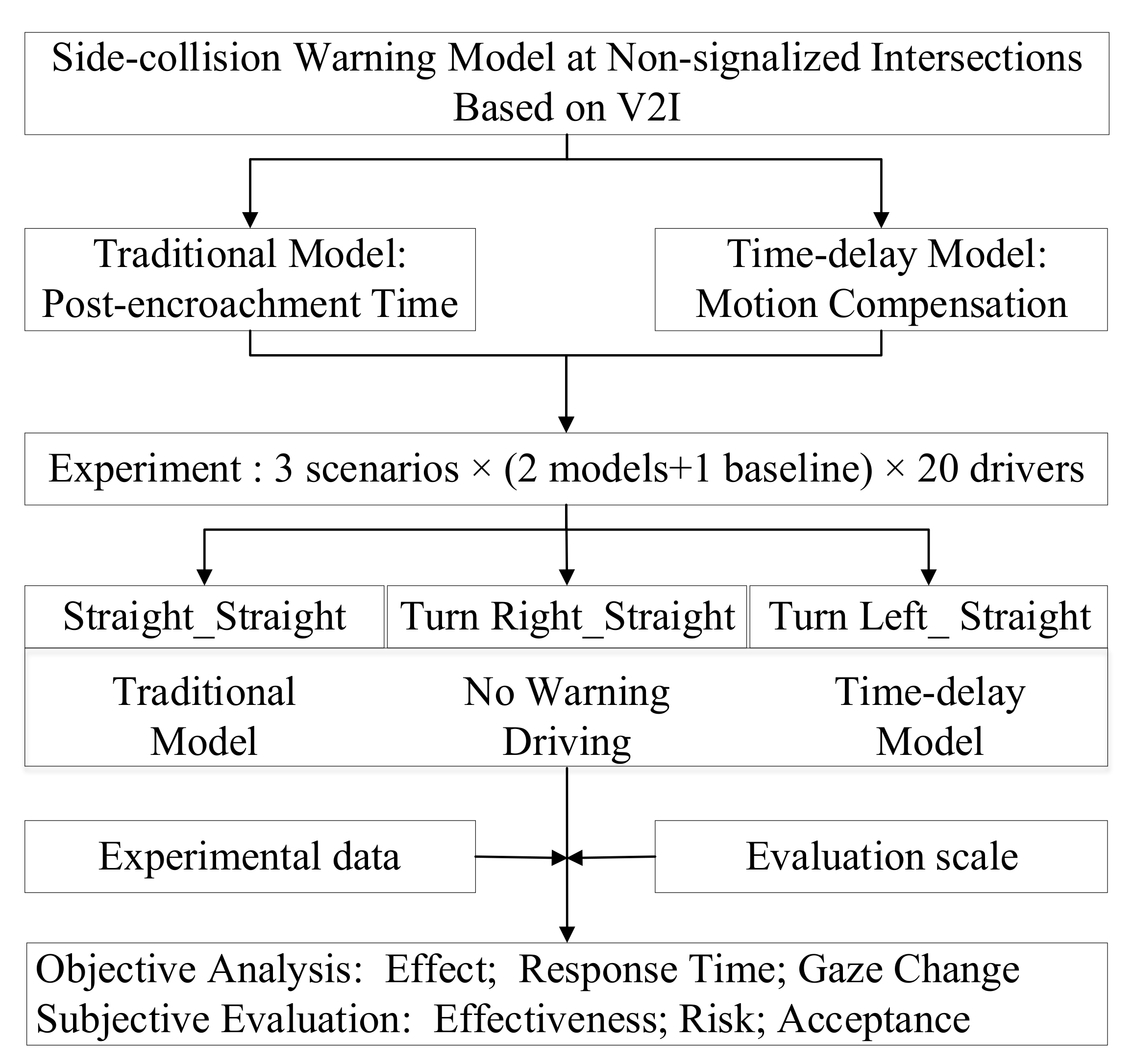
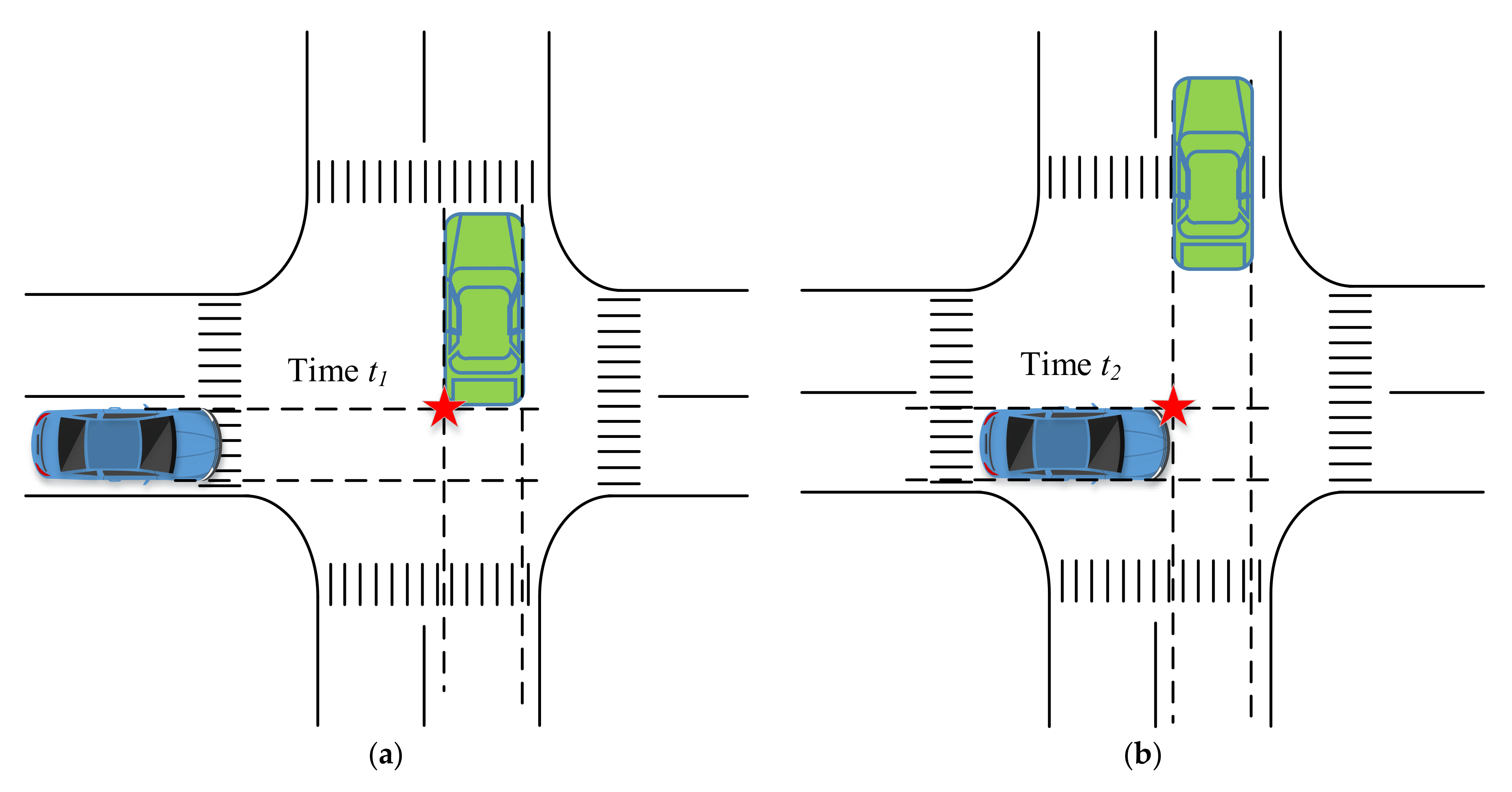
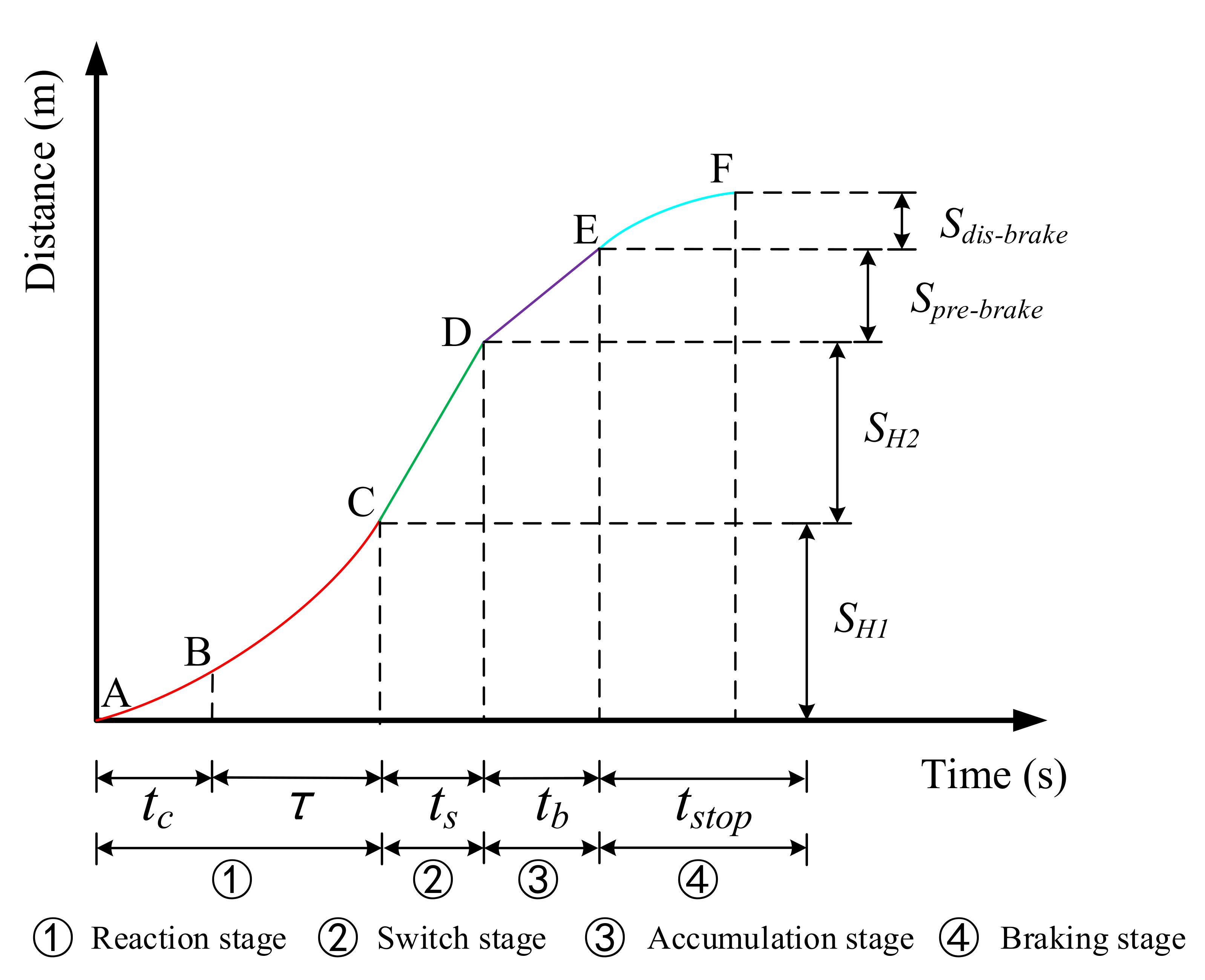
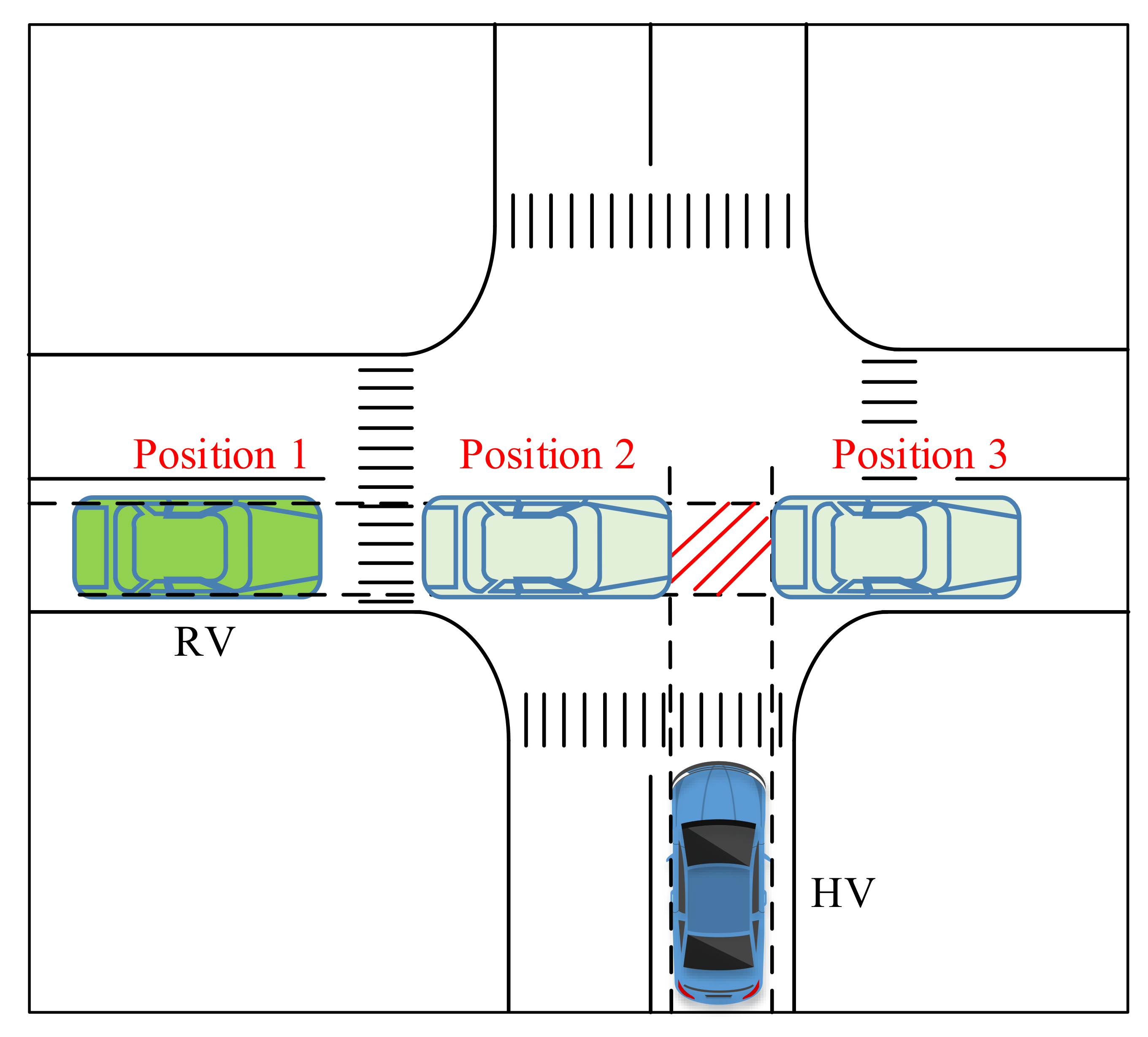
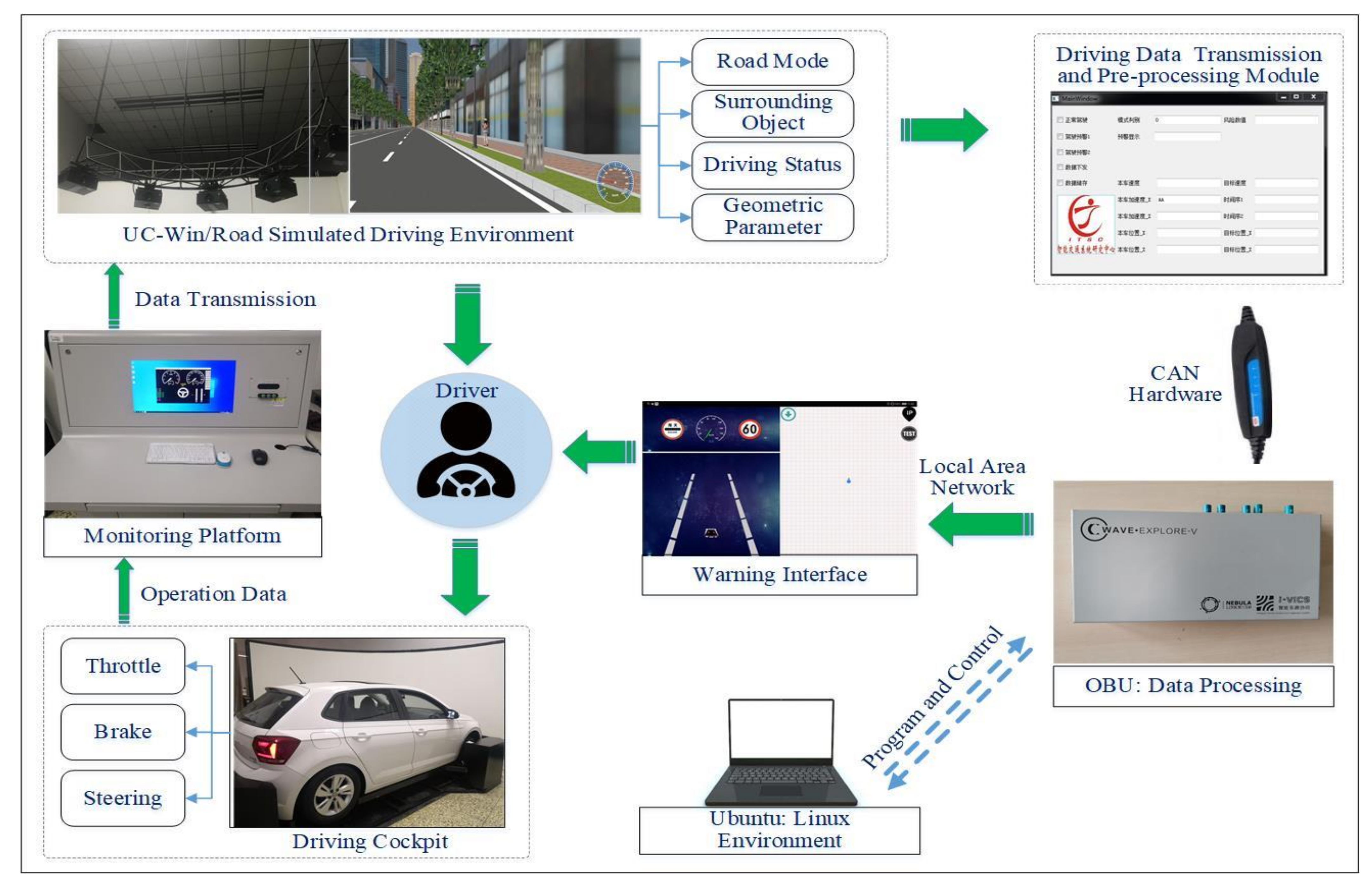
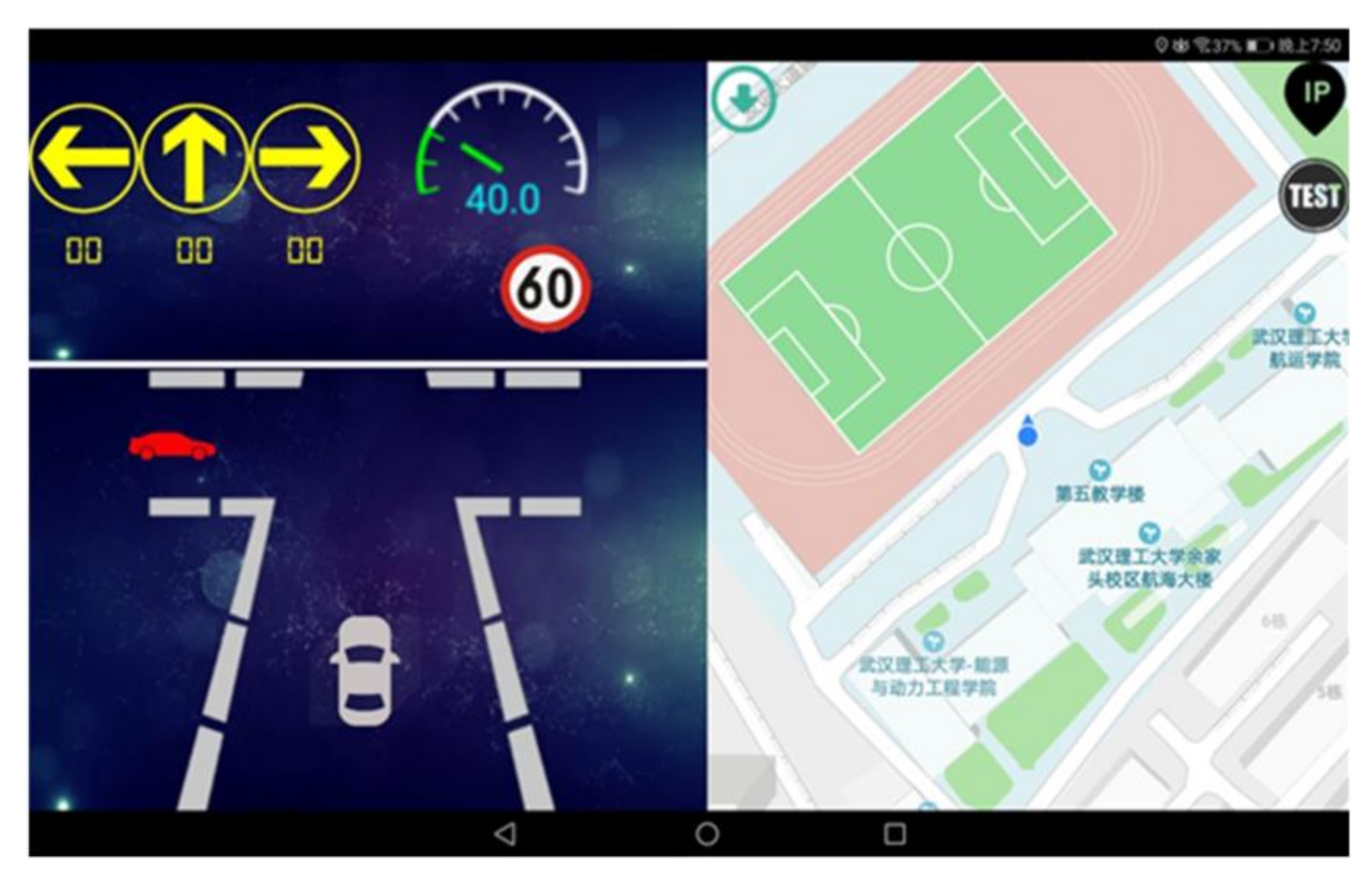


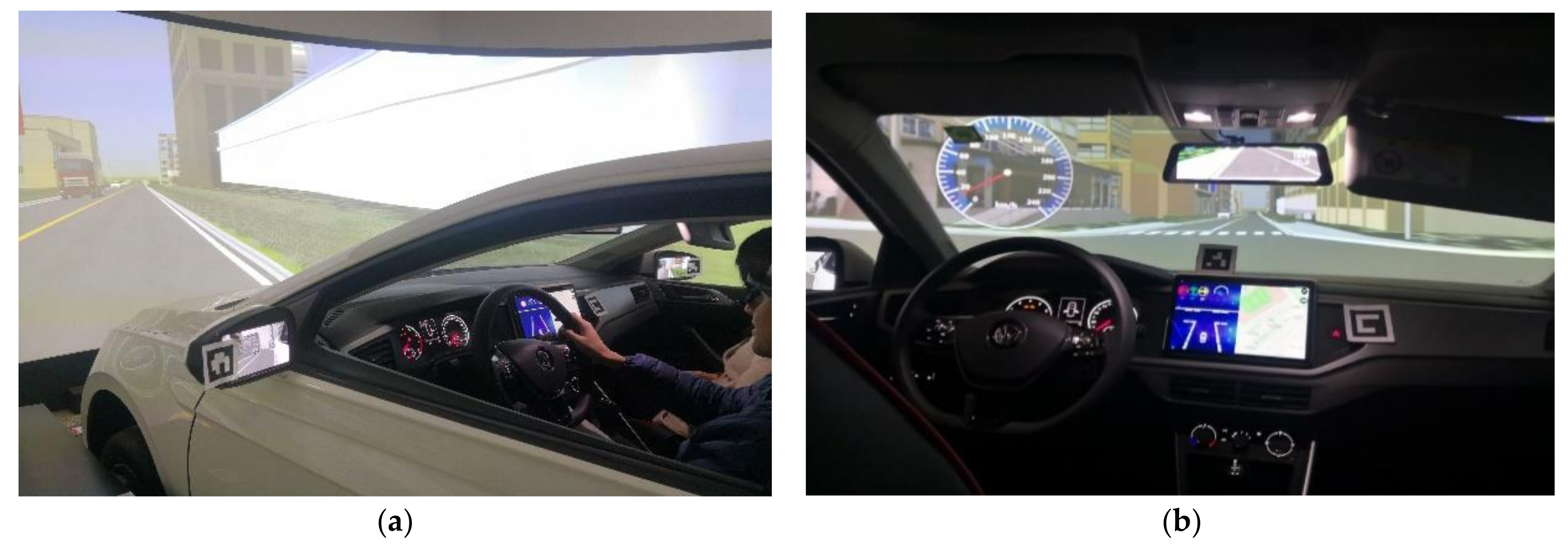
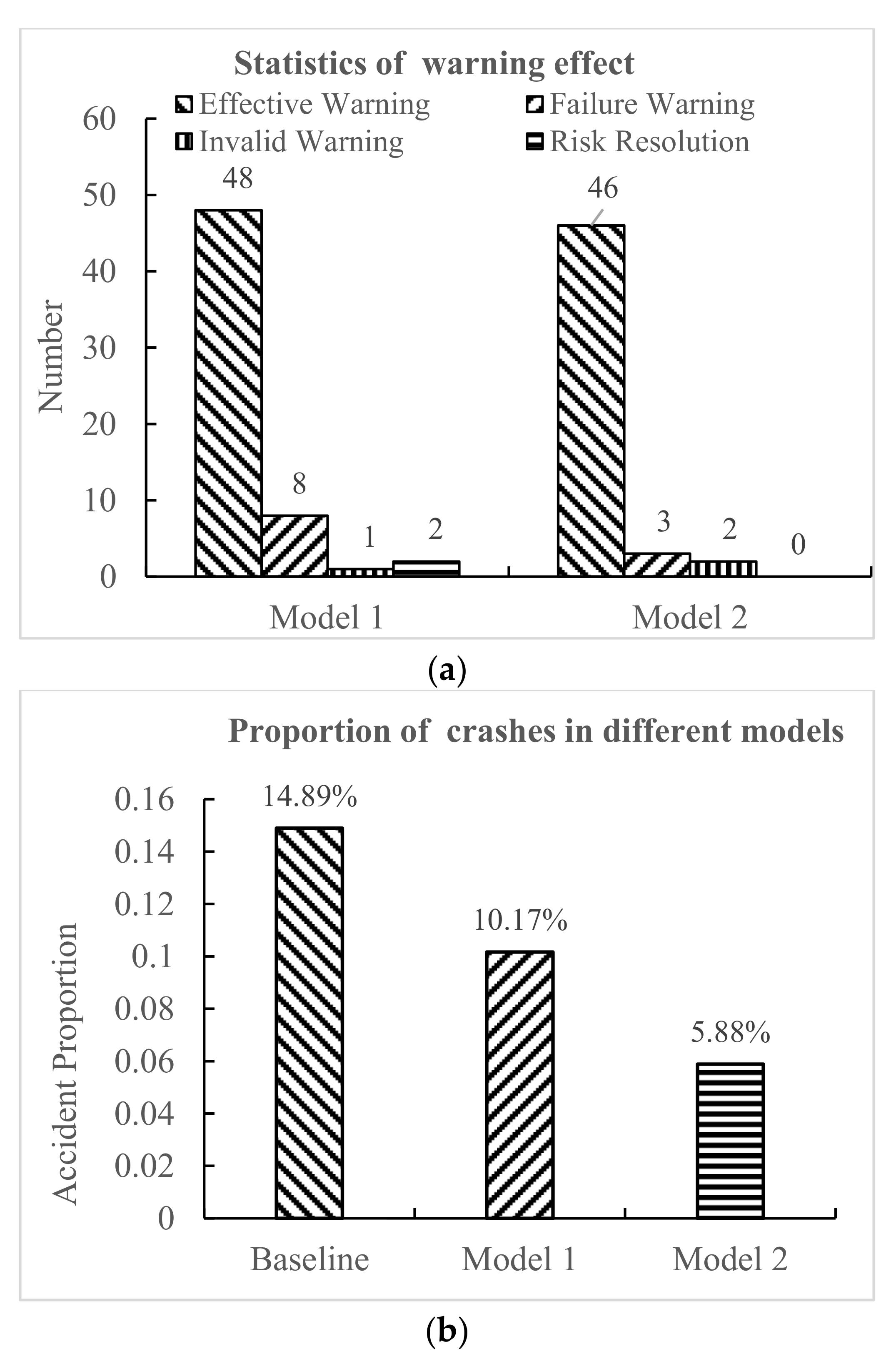
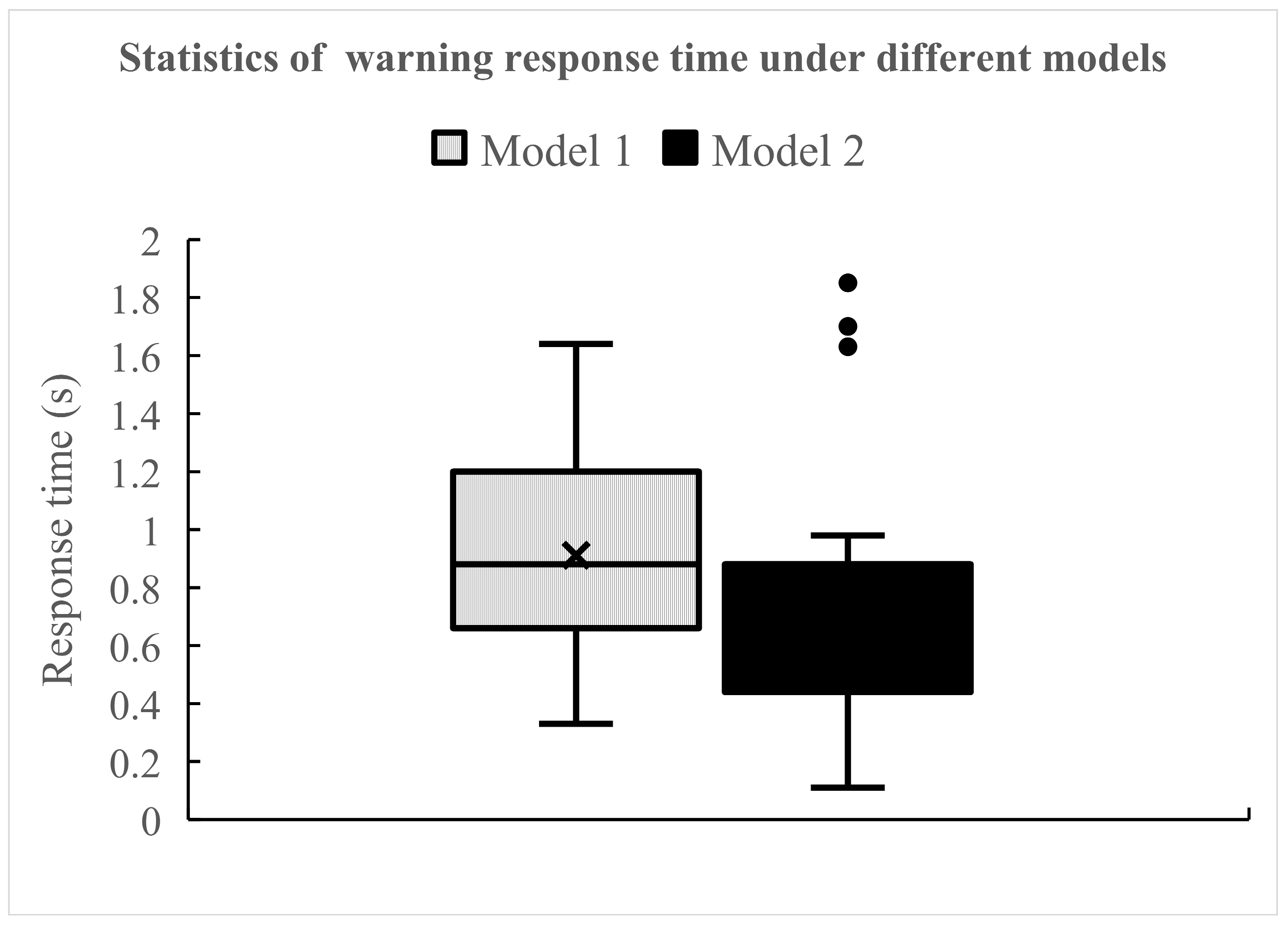
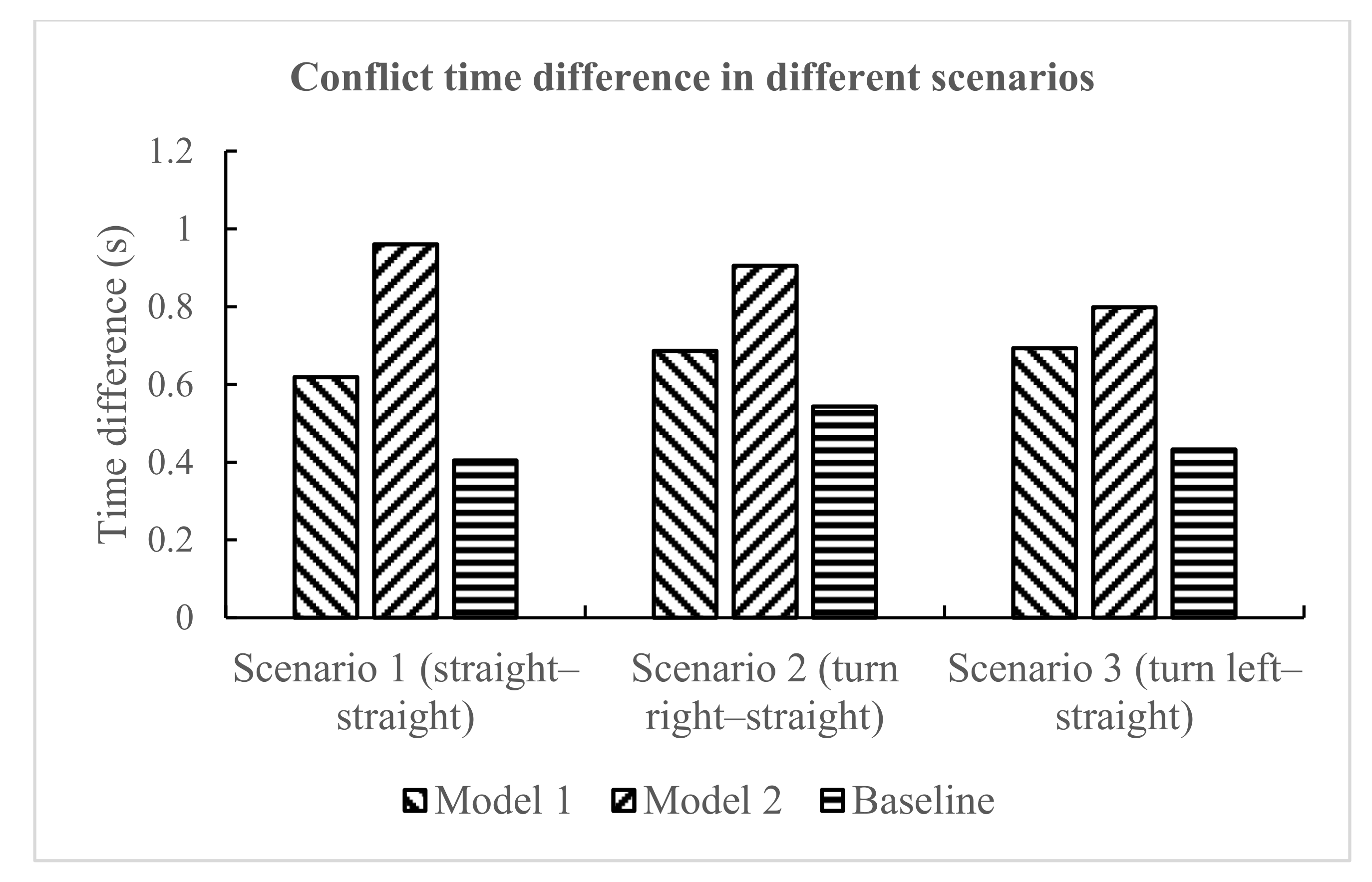
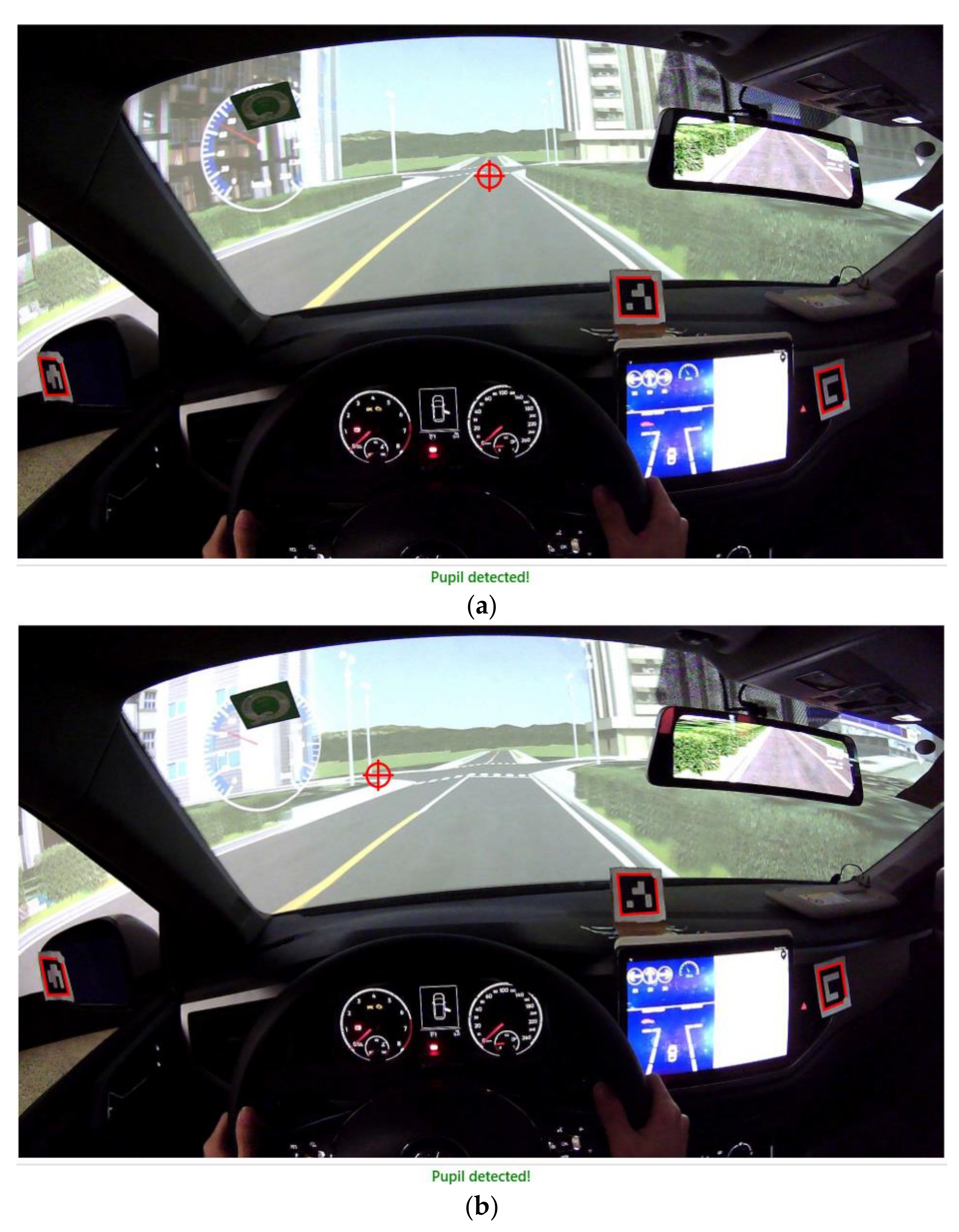

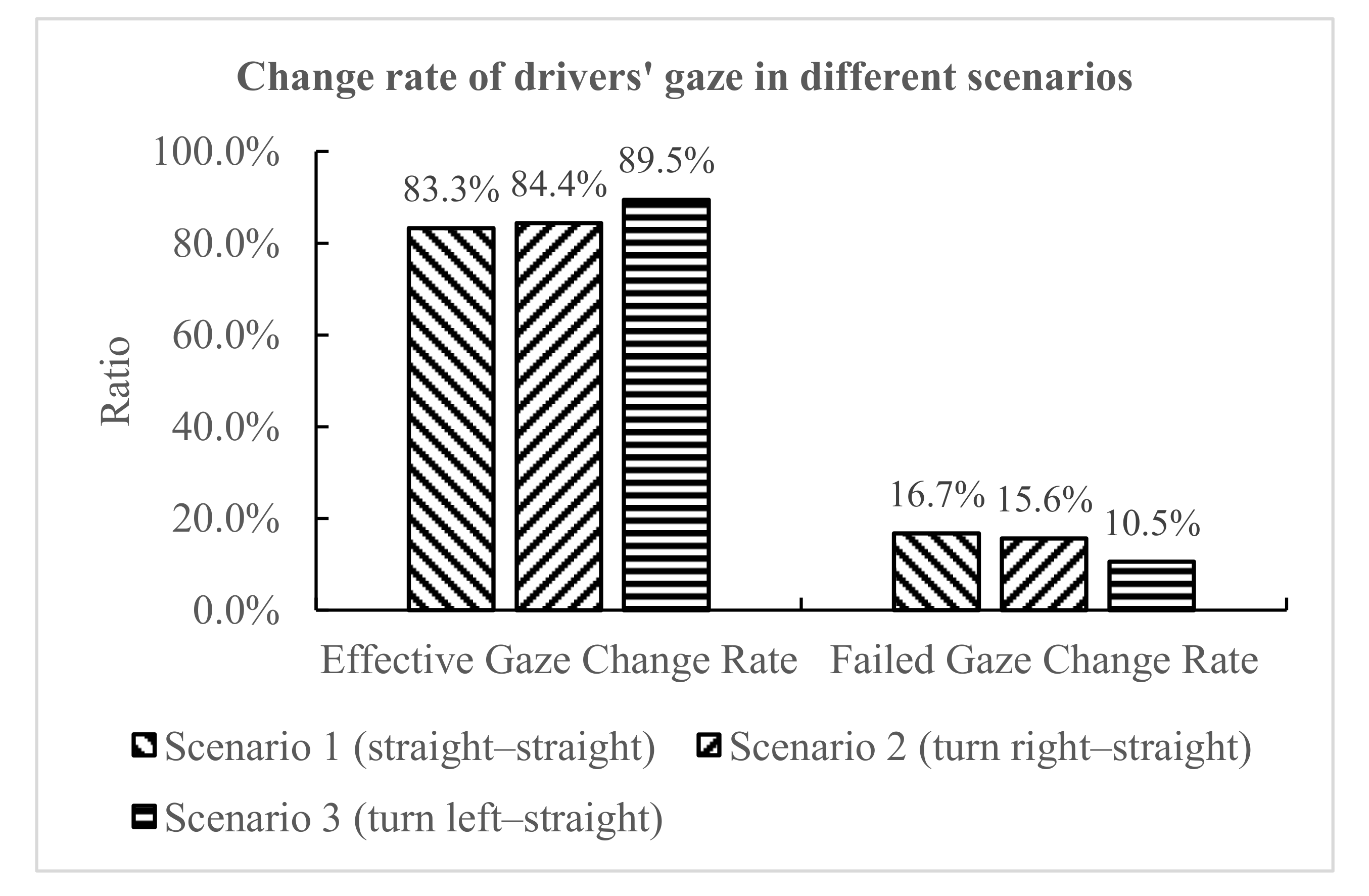
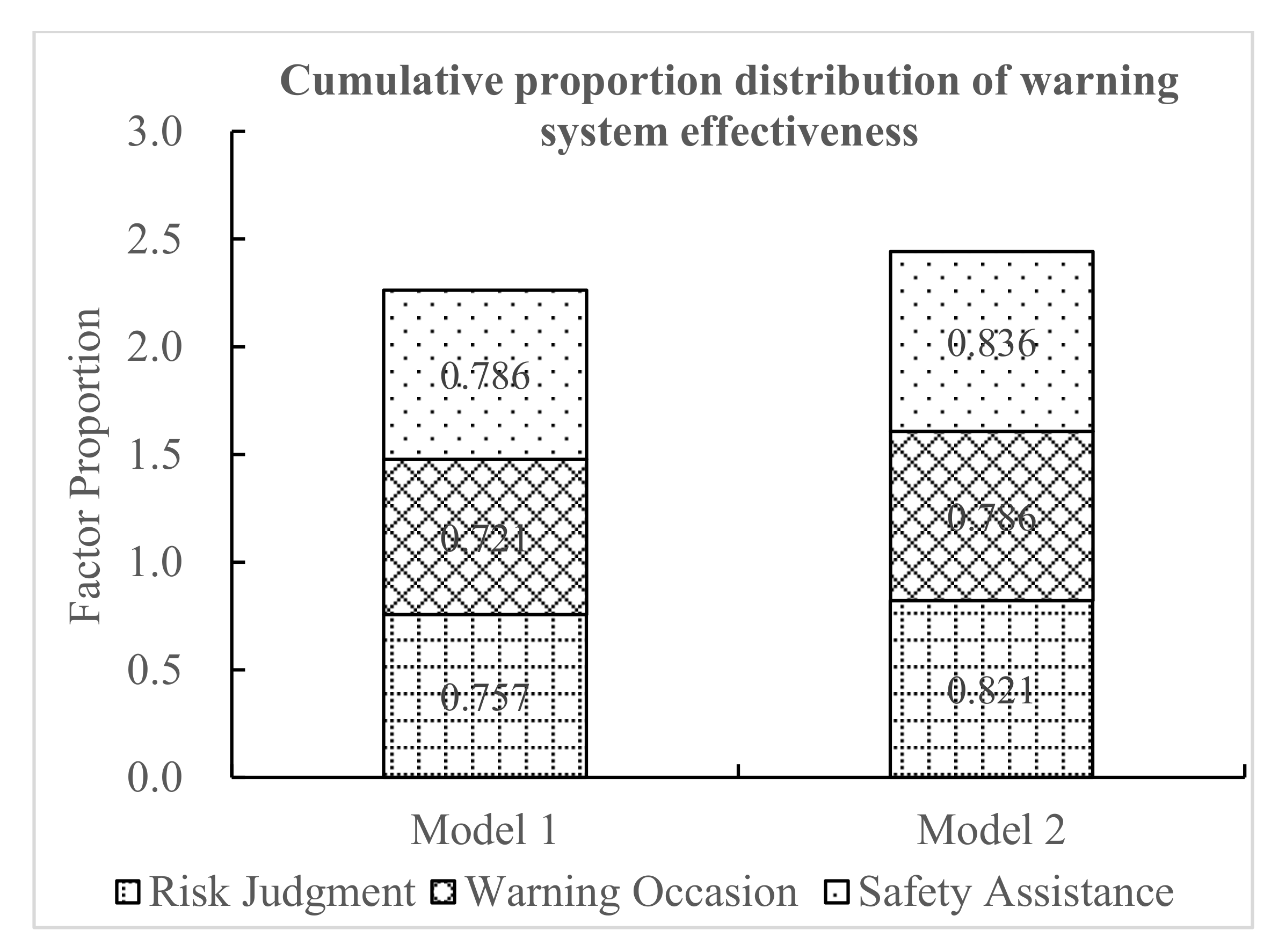

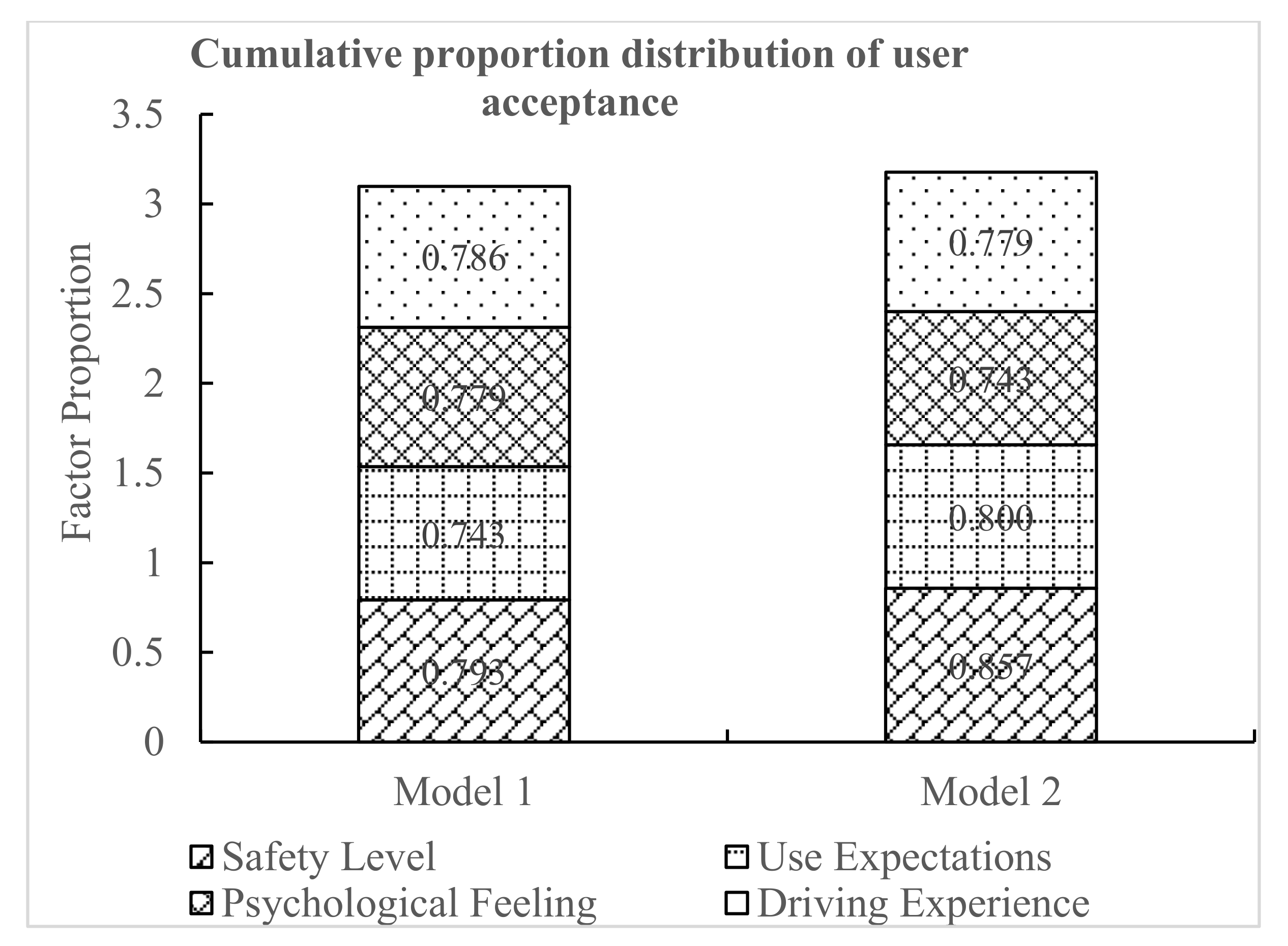
| Information | Definition | Unit | Category |
|---|---|---|---|
| ID | The unique number of the vehicle, which is used to distinguish different vehicles. | — | Target information |
| Speed | The real-time speed of the vehicle as it approaches the intersection. | km/h | |
| Acceleration | The real-time acceleration of the vehicle as it approaches the intersection. | m/s2 | |
| Coordinate position | Real-time 3D coordinate information of the vehicle. | m | |
| Remaining distance | The distance between the vehicle and the intersection. | m | |
| Outline | Length and width information of the vehicle. | m | |
| Special point | The center point coordinates of the intersection area. | m | Road information |
| Number of lanes | Number of one-way lanes at the intersection. | lane | |
| Lane width | Lane width in the intersection area. | m |
| Test Number | Scenario Type | Warning Model | Driving Data | Eye-Track Data | Evaluation Scale | Participants |
|---|---|---|---|---|---|---|
| 1 | Scenario 1 | Model 1 | ✓ | ✓ | ✓ | 20 drivers |
| 2 | Model 2 | ✓ | ✓ | ✓ | ||
| 3 | Baseline | ✓ | ✓ | — | ||
| 4 | Scenario 2 | Model 1 | ✓ | ✓ | ✓ | |
| 5 | Model 2 | ✓ | ✓ | ✓ | ||
| 6 | Baseline | ✓ | ✓ | — | ||
| 7 | Scenario 3 | Model 1 | ✓ | ✓ | ✓ | |
| 8 | Model 2 | ✓ | ✓ | ✓ | ||
| 9 | Baseline | ✓ | ✓ | — |
| Statistical Indicators | Warning Model | Baseline | |
|---|---|---|---|
| Model 1 | Model 2 | ||
| Available experiments | 59 | 51 | 47 |
| Effective warning | 48 | 46 | — |
| Failure warning | 8 | 3 | — |
| Invalid warning | 1 | 2 | — |
| Risk resolution | 2 | 0 | — |
| Collisions | 6 | 3 | 7 |
| Warning Model | Mean | Variance | Median Value | 75% Quantile | 90% Quantile |
|---|---|---|---|---|---|
| Model 1(s) | 0.91 | 0.10 | 0.88 | 1.2 | 1.31 |
| Model 2(s) | 0.78 | 0.21 | 0.66 | 0.88 | 1.64 |
| Warning Model | Experiment Scenario | ||
|---|---|---|---|
| Scenario 1 | Scenario 2 | Scenario 3 | |
| Model 1 (s) | 0.619 | 0.686 | 0.693 |
| Model 2 (s) | 0.961 | 0.905 | 0.799 |
| Baseline (s) | 0.404 | 0.543 | 0.433 |
| Model | Gaze Statistics | Effective Gaze Change | Irrelevant Gaze Change | Failed Gaze Change | Total |
|---|---|---|---|---|---|
| Warning model | Frequency | 91 | 2 | 15 | 108 |
| Proportion | 84.3% | 1.9% | 13.8% | 100% | |
| Baseline | Frequency | 37 | 2 | 8 | 47 |
| Proportion | 78.7% | 4.3% | 17.0% | 100% |
| Statistics Indicators | Scenario Category | ||
|---|---|---|---|
| Scenario 1 (Straight–Straight) | Scenario 2 (Turn Right–Straight) | Scenario 3 (Turn Left–Straight) | |
| Effective gaze change rate | 83.3% | 84.4% | 89.5% |
| Failed gaze change rate | 16.7% | 15.6% | 10.5% |
Publisher’s Note: MDPI stays neutral with regard to jurisdictional claims in published maps and institutional affiliations. |
© 2021 by the authors. Licensee MDPI, Basel, Switzerland. This article is an open access article distributed under the terms and conditions of the Creative Commons Attribution (CC BY) license (http://creativecommons.org/licenses/by/4.0/).
Share and Cite
Lyu, N.; Wen, J.; Wu, C. Novel Time-Delay Side-Collision Warning Model at Non-Signalized Intersections Based on Vehicle-to-Infrastructure Communication. Int. J. Environ. Res. Public Health 2021, 18, 1520. https://doi.org/10.3390/ijerph18041520
Lyu N, Wen J, Wu C. Novel Time-Delay Side-Collision Warning Model at Non-Signalized Intersections Based on Vehicle-to-Infrastructure Communication. International Journal of Environmental Research and Public Health. 2021; 18(4):1520. https://doi.org/10.3390/ijerph18041520
Chicago/Turabian StyleLyu, Nengchao, Jiaqiang Wen, and Chaozhong Wu. 2021. "Novel Time-Delay Side-Collision Warning Model at Non-Signalized Intersections Based on Vehicle-to-Infrastructure Communication" International Journal of Environmental Research and Public Health 18, no. 4: 1520. https://doi.org/10.3390/ijerph18041520
APA StyleLyu, N., Wen, J., & Wu, C. (2021). Novel Time-Delay Side-Collision Warning Model at Non-Signalized Intersections Based on Vehicle-to-Infrastructure Communication. International Journal of Environmental Research and Public Health, 18(4), 1520. https://doi.org/10.3390/ijerph18041520







